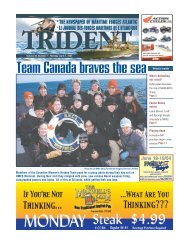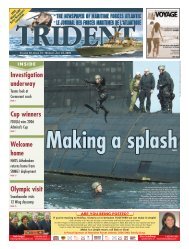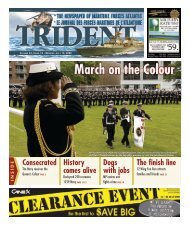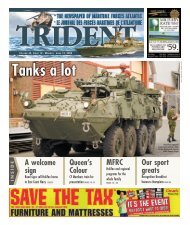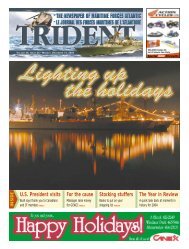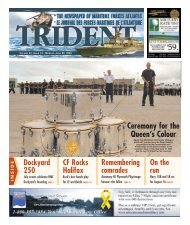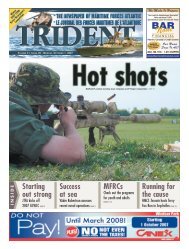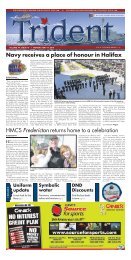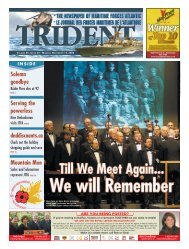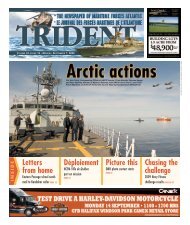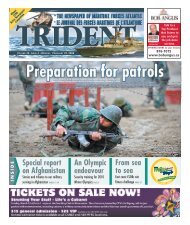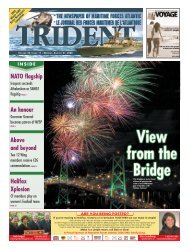Trident Feb 6 2006 - Tridentnews.ca
Trident Feb 6 2006 - Tridentnews.ca
Trident Feb 6 2006 - Tridentnews.ca
- No tags were found...
You also want an ePaper? Increase the reach of your titles
YUMPU automatically turns print PDFs into web optimized ePapers that Google loves.
TRIDENT, FEBRUARY 6, <strong>2006</strong> 3<br />
MCPL CHARLES BARBER<br />
Cmdre Rouleau shakes hands with his predecessor, RAdm Kalahne, at the change of command ceremony. To the right is Capt(N) Dave Gardam, the CO of HMCS Athabaskan.<br />
By Virginia Beaton<br />
<strong>Trident</strong> staff<br />
During a change of command<br />
ceremony in Kiel, Germany<br />
on Thursday January 26, Commodore<br />
(Cmdre) Denis Rouleau<br />
took command of the Standing<br />
NATO Maritime Group 1 (SNMG 1).<br />
Cmdre Rouleau succeeded Admiral<br />
Wolfgang Kalahne of the German<br />
navy. Under Cmdre Rouleau,<br />
HMCS Athabaskan will be flagship<br />
for the Standing Element of the maritime<br />
component of the NATO<br />
Response Force Rotation 7 (NRF7)<br />
until July <strong>2006</strong>, at which time Iroquois<br />
will succeed it as flagship.<br />
In a teleconference after the ceremony,<br />
Cmdre Rouleau described<br />
the SNMG1 as “a unique asset”<br />
within NATO.<br />
“We <strong>ca</strong>n be <strong>ca</strong>lled upon to deploy<br />
at short notice,” he stated, adding<br />
that SNMG1 <strong>ca</strong>n deploy within five<br />
days.<br />
During <strong>2006</strong>, Cmdre Rouleau<br />
and the 21 members of his international<br />
staff will head up a squadron<br />
of NATO ships from the navies of<br />
Canada, the United States, Germany,<br />
Poland, Portugal, Denmark,<br />
and Spain.<br />
Cmdre Rouleau stated that the<br />
Commodore Rouleau takes command of SNMG1<br />
true strength of SNMG1 comes not<br />
only from the ships and their<br />
weapons, but also from the shared<br />
commitment to NATO and its guiding<br />
principles.<br />
In response to a question concerning<br />
the way that the international<br />
navies cooperate while deployed<br />
on such operations, Cmdre Rouleau<br />
pointed out “NATO units have been<br />
operating together for a long time.<br />
We’re talking de<strong>ca</strong>des here.” He<br />
further stated “The commonality of<br />
operating procedures allows them to<br />
be interoperable.”<br />
Immediate plans for SNMG1<br />
included sailing to Denmark, “and<br />
operating in the Baltic Sea... My job<br />
is to get them to work well together.”<br />
Following this, the ships sail to<br />
the coast of Norway, where they<br />
will be near Bergen. The next stage<br />
will involve sailing to the Mediterranean<br />
for OPERATION ACTIVE<br />
ENDEAVOUR, “which takes them<br />
into March,” according to Cmdre<br />
Rouleau.<br />
The first six months of the 12-<br />
month NRF commitment are a preparation<br />
phase, which will be followed<br />
by a six-month standby phase.<br />
SNMG1 is a permanent naval<br />
squadron that trains and operates as<br />
a group in the North Atlantic, the<br />
North Sea and the Mediterranean<br />
Sea, in order to test NATO’s current<br />
maritime procedures and tactics.<br />
SNMG1 comprises destroyers,<br />
frigates and on oc<strong>ca</strong>sion, auxiliary<br />
oiler replenishment ships.<br />
NRF is a high readiness force<br />
including land, sea, air and special<br />
forces components that NATO may<br />
deploy on short notice as a standalone<br />
force to prevent conflicts<br />
from es<strong>ca</strong>lating. Deployed as an<br />
initial entry force, NRF <strong>ca</strong>n facilitate<br />
the arrival of follow-on units,<br />
join a larger force, and contribute to<br />
the full range of NATO military<br />
operations.<br />
New SNMG1 flagship completes its first port visit<br />
By Cdr Chris Dickinson<br />
Squadron Public Affairs Officer<br />
SNMG1<br />
Between January 23 and 30,<br />
<strong>2006</strong>, the Canadian destroyer<br />
HMCS Athabaskan conducted a<br />
port visit to Kiel, Germany where it<br />
assumed its new role as the flagship<br />
of Standing NATO Maritime Group<br />
One (SNMG1).<br />
As of this week, the Force consists<br />
of HMCS Athabaskan, FGS<br />
Mecklenburg-Vorpommern, ORP<br />
General Kazimierz Pulaski, NRP<br />
Vasco Da Gama, and USS Simpson.<br />
The visit to Kiel was special in<br />
many ways. It was the point of<br />
reassembly for the Force after<br />
Christmas dispersal; it was the<br />
first port of <strong>ca</strong>ll for ORP General<br />
Kazimierz Pulaski, the first Polish<br />
ship to join the Force on a fulltime<br />
basis; it was the homeport of the<br />
out-going Commander of the<br />
Force, Rear Admiral Wolfgang<br />
Kalahne; and the spot chosen for<br />
the turnover of the Force to its<br />
new Canadian Commander, Commodore<br />
Denis Rouleau.<br />
It was an extremely busy week<br />
for the 1000-plus sailors, marines,<br />
soldiers and airmen of SNMG1.<br />
After arriving alongside on Monday<br />
the German and Canadian<br />
Staffs started their turnovers. Meanwhile,<br />
the five international staff<br />
officers, representing Germany, the<br />
Netherlands, Portugal, Spain and<br />
the United Kingdom made themselves<br />
comfortable in their new<br />
home onboard Athabaskan.<br />
By Thursday, January 26, <strong>2006</strong><br />
everything had been prepared for<br />
the operational change of command<br />
ceremony held in the Gym of Kiel<br />
Naval Station.<br />
The ceremony was attend by<br />
many dignitaries including General<br />
Wolfgang Schneiderhan, the Chief<br />
of Staff German Armed Forces and<br />
and Vice Admiral Glenn Davidson,<br />
Canadian Military Representative<br />
to NATO.<br />
The parade opened with a surprise,<br />
as the Squadron Operations<br />
Officer, Commander Gunnar Wolff,<br />
was promoted to his new rank in<br />
front of the assembly.<br />
In his address to the parade General<br />
Schneiderhan highlighted the<br />
importance of NATO in maintaining<br />
peace in Europe during the Cold War.<br />
As a native of Kiel, the outgoing<br />
Commander, Rear Admiral Kalahne,<br />
recognized the importance of the<br />
Kiel, and thanked his crew and staff<br />
for their magnificent work over the<br />
past 10 months of his command.<br />
After taking over the Force officially,<br />
Cmdre Rouleau commenced<br />
his address with a strong statement<br />
that summed up his commitment to<br />
ensuring that SNMG1 was ready to<br />
respond to its tasks within the concept<br />
of NATO Reaction Force 7.<br />
“As I assume command of this<br />
naval formation of multinational<br />
units, I do so with the firm intention<br />
of bringing it to its highest level of<br />
operational <strong>ca</strong>pabilities, and to<br />
stand ready to respond to the multitude<br />
of possible tasks likely expected<br />
of us.” Cmdre Rouleau went on<br />
to praise the fact that only the<br />
Standing Maritime Groups of the<br />
NATO Response Force <strong>ca</strong>n claim<br />
histori<strong>ca</strong>lly to have proven and<br />
demonstrated a real <strong>ca</strong>pability over<br />
the de<strong>ca</strong>des.<br />
Finally, Cmdre Rouleau completed<br />
his speech with a tribute to his<br />
crews and the loved ones they leave<br />
behind when sailing with the Force.<br />
On the weekend the Force took<br />
the opportunity to open to visitors,<br />
attracting several hundred interested<br />
guests.<br />
On Sunday afternoon, Commodore<br />
Rouleau visited the German<br />
Naval Memorial at Laboe with<br />
his staff.<br />
After a wreath laying and a short<br />
service, in the Commemorative<br />
Hall, the group was given a tour<br />
by Dr Dieter Hartwig of the German<br />
Naval Association (Deutsche<br />
Marinebund).<br />
On Monday, January 30, the Force<br />
joined a Danish naval exercise<br />
(SQUADEX 05-06), which will give<br />
the new ships of the Force their first<br />
opportunity to integrate into the<br />
SNMG1 environment through a<br />
series of maritime warfare exercises.




